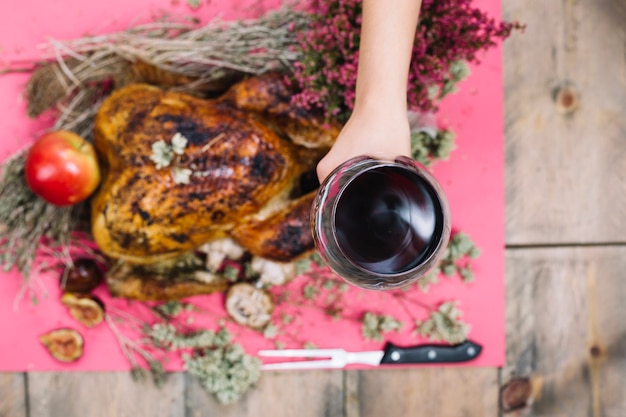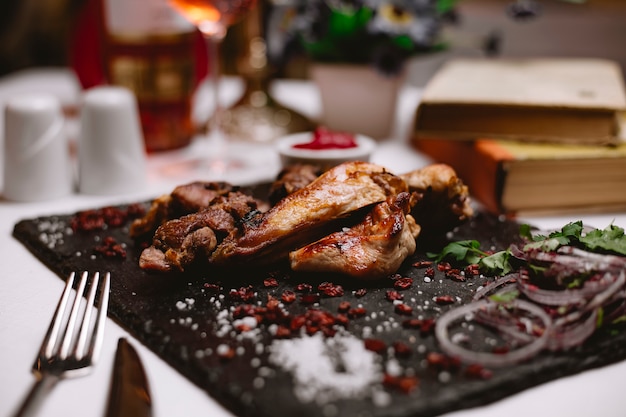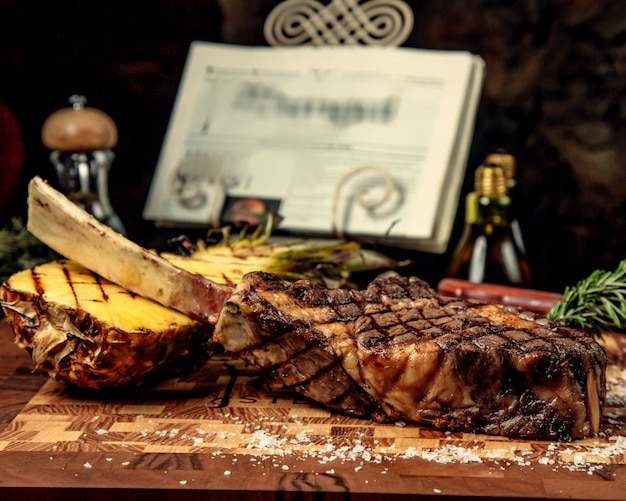Let's talk prime rib! I'm a bit of a grill master, and I've spent years perfecting my skills, but I have to say, there's something truly special about a perfectly cooked prime rib roast. It’s a dish that demands respect, a bit of patience, and a dash of culinary expertise. It's worth the effort, I promise! The juicy, melt-in-your-mouth meat, the rich, flavorful juices, the satisfying crunch of the crust – pure bliss! But let's be honest, cooking a prime rib can be daunting, especially if you're unfamiliar with the timings and techniques. Worry not! I'm here to guide you, step by step, so you can impress your family and friends with a show-stopping feast.
(Part 1) Understanding the Basics

Before we dive into the details, let's get the fundamentals sorted. We're dealing with a hefty cut of meat, and we need to understand its anatomy and how to cook it properly.
1. Prime Rib Anatomy: A Culinary Crown Jewel
Think of a prime rib as a culinary crown jewel. It's a cut taken from the rib section of a cow, typically with the bones still attached. The bone adds incredible flavor, so don't even think about removing it! The meat itself is divided into sections, or "primals" as the butchers call them. You'll often find a prime rib labelled as a "standing rib roast", which is made up of three to four ribs. It's a beautiful sight! Depending on the size, you might have a "rolled rib roast", where the butchers have taken that stunning rib section, rolled it up, tied it with butcher's twine, and created a neat, compact roast. But no matter the form, the essence remains the same: pure deliciousness!
2. Temperature Matters: The Key to Perfect Doneness
We're aiming for a roast that's cooked to perfection, with a beautiful pink center and a delectable crust on the outside. To achieve this, we need to understand the internal temperature. The USDA recommends a minimum internal temperature of 145°F (63°C) for a safe and delicious prime rib. However, I'm a bit of a purist, and I prefer my prime rib cooked to a slightly lower temperature, like 135°F (57°C) for medium-rare. It's just a personal preference, but that touch of pinkness makes it oh so juicy! Ultimately, it's about finding the level of doneness that you enjoy the most.
(Part 2) Getting Ready for the Roast: Preparation is Key

Now that we've covered the basics, let's get down to business. Preparation is key to a successful prime rib roast.
1. Choosing the Prime Rib: Selecting Your Culinary Star
You've set your sights on a prime rib, but what should you look for? Here's the lowdown. First, you want a roast with a good amount of marbling – those streaks of white fat throughout the meat. They add flavor and tenderness. Second, choose a roast that's evenly shaped and has a nice, firm texture. You're aiming for a roast that's been properly aged, too, which enhances the flavour and tenderness. It's a good idea to ask your butcher for advice on selecting the perfect prime rib.
2. The Day Before: A Little Secret for Extra Tenderness
I have a little trick up my sleeve, a secret weapon for the ultimate prime rib. A day before you're ready to cook, take your prime rib out of the refrigerator and let it sit at room temperature for about two hours. Yes, room temperature! This allows the meat to even out in temperature and makes it easier to cook evenly. Now, here's the crucial bit. Once it's at room temperature, pat it dry with paper towels, season it liberally with salt and pepper, and then rub it with a blend of your favourite herbs and spices. Think rosemary, thyme, garlic powder, onion powder, paprika, and a pinch of cayenne pepper for a little heat. Get creative, experiment, and find your signature blend. Once you've done your magic, cover the roast with plastic wrap and pop it back in the refrigerator. You can thank me later for this little tip, it really makes a difference!
(Part 3) roasting techniques: Mastering the Art of Prime Rib

Ready to start cooking? Let's explore the techniques that will take your prime rib to the next level.
1. Slow and Steady: A Gentle Approach to Tenderness
For a consistently cooked roast, I recommend slow roasting. The key is to cook the roast at a low temperature, allowing the meat to cook gently and evenly. Aim for a temperature between 300°F (149°C) and 325°F (163°C). This method takes a little longer, but it's worth it for that meltingly tender texture and perfect sear.
2. reverse searing: A Two-Step Process for Ultimate Flavor
Here's a technique that's gaining popularity, and for good reason. It's a bit like the slow roast, but with a twist. The idea is to cook the roast at a low temperature until it reaches an internal temperature just below your desired final temperature. So, if you're aiming for 135°F (57°C), cook it until it hits about 125°F (52°C). Now, here's the magic. Once it's reached that temperature, crank up the heat to high, sear the roast on all sides, and get that beautiful crust. It's a game-changer, trust me!
(Part 4) Timing is Everything: A Guide to Cooking Time
We've talked about temperatures, but what about the timings? Here's how to figure out the cooking time for your prime rib roast. It's all about the weight!
1. The Weight Game: Estimating Your Cooking Time
To estimate the cooking time, I use a simple rule of thumb: calculate about 15 minutes per pound for a medium-rare prime rib, cooked at 325°F (163°C). For example, if you have a 5-pound prime rib, it'll take approximately 75 minutes. Now, remember that this is just a guide. It's always best to use a meat thermometer to ensure the meat is cooked to your desired temperature.
2. Checking the Progress: Avoiding Overcooking
Here's a little trick that helps me avoid overcooking. After about an hour of cooking, check the internal temperature of the roast using a meat thermometer. If it's still too low, continue cooking for another 15 minutes, and check again. Just keep checking every 15 minutes or so until it reaches your desired temperature. It's always better to err on the side of caution and check those temperatures more often, rather than risk overcooking the beautiful roast.
(Part 5) Resting is Key: Allowing the Juices to Redistribute
You've cooked the roast, and it's looking delicious. But before you carve it, there's one final step that's crucial for achieving that juicy, tender masterpiece: let it rest.
1. The Restful Roast: A Crucial Step for Tenderness
Once the roast has reached your desired internal temperature, remove it from the oven and tent it loosely with aluminium foil. Now, leave it to rest for at least 15 minutes. This allows the juices to redistribute throughout the meat, making it incredibly tender and succulent. Don't worry about it getting cold, the foil will help retain the heat and keep it warm. The longer you let it rest, the more tender and flavorful it will become.
2. Juicy Goodness: Creating a Delicious Gravy
As you carve the roast, you'll notice those beautiful juices pooling at the bottom. Don't waste them! I like to use those juices as a delicious gravy. Just spoon some of the juices into a saucepan, add a little flour and water, and simmer until it thickens. It's a simple but effective way to enhance the flavour of your prime rib even further.
(Part 6) Serving Up the Star: A Culinary Triumph
The moment has finally arrived. You've done all the hard work, the prime rib is rested and ready to be enjoyed.
1. Carving with Care: Presenting Your Masterpiece
When carving, use a sharp knife, folks. It makes a world of difference. Cut between the bones, starting at one end of the roast. Then, slice the meat into even portions, about half an inch thick. I like to arrange the slices on a platter, along with some of the roasted vegetables.
2. side dishes: Completing the Feast
No prime rib roast is complete without a perfect side dish. My personal favourites? Roasted potatoes, asparagus, and a creamy horseradish sauce. The combinations are endless! Experiment and find what you enjoy most.
(Part 7) Don't Be Afraid to Experiment: Elevating Your culinary skills
Okay, so we've covered the basics, but you know what? Cooking is all about experimentation and creativity. Don't be afraid to try different techniques, flavours, and spices.
1. Spice Blends: Creating Your Signature Flavor
Try different combinations of herbs and spices for your rub. I've experimented with everything from rosemary and thyme to garlic and paprika. You can even add a touch of citrus zest or a hint of chili powder for a bit of heat.
2. Cooking Methods: Exploring New Frontiers
You can also try different cooking methods, like cooking your prime rib in a smoker or on a grill. The possibilities are endless, folks!
(Part 8) Enjoying the Prime Rib: A Culinary Celebration
The final step: Enjoy! This is what it's all about, folks. Take your time, savor every bite, and enjoy the fruits of your labor.
1. The Ultimate Feast: A Culinary Masterpiece
A perfectly cooked prime rib roast is a celebration, a culinary masterpiece that will impress your guests and make your taste buds sing. It's a dish that deserves to be savored, shared, and remembered.
2. Share the Joy: Creating Memories
Remember, cooking is about sharing and creating memories. So gather your loved ones, enjoy the meal, and share the joy of a beautifully cooked prime rib. Cheers!
FAQs
1. Can I cook prime rib in a slow cooker?
While a slow cooker can be used for other cuts of beef, it's not the ideal method for prime rib. The slow cooker environment can lead to a roast that's too tender, even mushy. I recommend sticking to the oven or grill for a perfectly cooked prime rib.
2. How long can I keep a prime rib in the fridge?
Fresh prime rib can be stored in the fridge for 3-5 days. However, I'd recommend using it within 3 days for the best flavour and texture.
3. What happens if I overcook the prime rib?
Overcooking a prime rib can lead to dry, tough meat. It loses its tenderness and juicy flavour. Always check the internal temperature with a meat thermometer and ensure it's cooked to your desired level of doneness.
4. Can I freeze prime rib?
You can freeze prime rib, but it's best to freeze it before seasoning it. It's recommended to freeze it wrapped tightly in plastic wrap and then in heavy-duty foil or freezer paper. It can be frozen for up to 3 months. To defrost, thaw it in the refrigerator for 3-4 days before cooking.
5. What's the best way to reheat prime rib?
If you have leftover prime rib, you can reheat it in the oven at 325°F (163°C) for about 15-20 minutes, or until it reaches an internal temperature of 145°F (63°C). You can also reheat it in a skillet on the stovetop over medium heat, adding a little bit of broth or water to keep it moist.
Everyone is watching

Prime Rib Roast Cooking Time Chart: Per Pound Guide
Cooking TipsPrime rib roast. Just the name conjures images of lavish dinners, crackling fires, and hearty laughter. It’s ...

How Long to Bake Potatoes in the Oven (Perfect Every Time)
Cooking TipsBaked potatoes are a staple in my kitchen. They're incredibly versatile, delicious, and surprisingly easy to m...

Perfect Rice Every Time: The Ultimate Guide to Cooking Rice
Cooking TipsAs a self-proclaimed foodie, I've always been a bit obsessed with rice. It's the foundation of countless cuisi...

The Ultimate Guide to Cooking Asparagus: Tips, Techniques, and Recipes
Cooking TipsAsparagus. The mere mention of this spring delicacy conjures up images of vibrant green spears, crisp and burs...

Ultimate Guide to Cooking the Perfect Thanksgiving Turkey
Cooking TipsThanksgiving. Just the word conjures up images of overflowing tables laden with delicious food, the scent of r...
